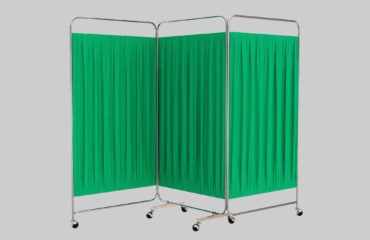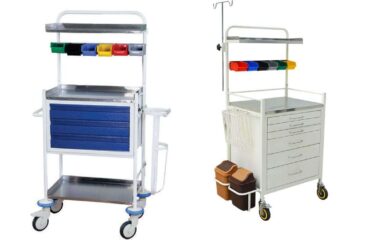Hospital furniture plays a crucial role in ensuring the comfort, safety, and efficiency of healthcare environments.

Here are 20 essential types of hospital furniture that every hospital should have:
Hospital Beds:
Adjustable hospital beds that can be raised, lowered, and repositioned to enhance patient comfort and facilitate medical procedures.
Examination Tables:
Sturdy tables where patients can be examined by healthcare professionals.
Bedside Lockers:
Small storage units next to patient beds for personal belongings and medical supplies.
Overbed Tables:
Adjustable tables that can be positioned over the bed for patients to use for eating or other activities.
Wheelchairs:
Essential for transporting patients who cannot walk or have difficulty walking.
Stretchers:
Used for transporting patients in emergencies and between departments.
Recliner Chairs:
Comfortable chairs for patients and visitors, often with reclining capabilities.
Patient Transfer Chairs:
Chairs designed for safely moving patients between locations within the hospital.
Ward Screens/Privacy Curtains:
Provide privacy for patients during examinations and treatments.
IV Stands/Poles:
Hold intravenous fluid bags and equipment.
Medicine Trolleys:
Mobile carts used for storing and transporting medications and medical supplies.
Operating Tables:
Operating table or hydraulic OT table specialized tables used in surgical procedures, adjustable for various positions.
Bedside Commodes:
Portable toilets for patients who have difficulty reaching the bathroom.
Infant Cribs/Bassinets:
Safe sleeping areas for newborns in maternity and pediatric wards.
Blood Donor Chairs:
Comfortable chairs specifically designed for blood donation procedures.
Patient Lifts/Hoists:
Equipment used to safely lift and move patients with limited mobility.
Dining Chairs and Tables:
For patient and staff use in hospital dining areas.
Medical Storage Cabinets:
Secure storage for medications, supplies, and equipment.
Examination Lights:
Adjustable, high-intensity lights used during patient examinations and minor procedures.
Laundry Carts:
Used for transporting soiled and clean linens within the hospital.
These pieces of furniture are essential for the smooth operation of a hospital, ensuring that patients receive the best care possible while maintaining a safe and efficient environment for healthcare providers.
What is the role of hospital furniture in medical facilities?
Hospital furniture plays a critical role in medical facilities, impacting patient care, comfort, and the efficiency of healthcare delivery. Here are several key roles that hospital furniture serves:
Patient Comfort and Care
- Comfort: Hospital furniture such as beds, recliner chairs, and bedside lockers are designed to provide comfort to patients during their stay. Adjustable beds and ergonomic chairs help in reducing discomfort and pain, which is essential for patient recovery.
- Dignity and Privacy: Furniture like ward screens and privacy curtains help maintain patient dignity and privacy during examinations and treatments.
Facilitating Medical Procedures
- Efficiency in Treatment: Examination tables, operating tables, and patient lifts are designed to facilitate various medical procedures, making it easier for healthcare professionals to perform their tasks efficiently.
- Accessibility: Overbed tables and IV stands ensure that necessary equipment and supplies are easily accessible to both patients and healthcare staff.
Enhancing Mobility and Safety
- Safe Movement: Wheelchairs, stretchers, and patient transfer chairs ensure safe and efficient movement of patients within the hospital, reducing the risk of injuries.
- Stability and Support: Hospital beds and infant cribs/bassinets provide stability and support to patients, especially those who are vulnerable, such as infants and elderly patients.
Improving Hospital Operations
- Organizational Efficiency: Medicine trolleys, medical storage cabinets, and laundry carts help in organizing and storing medical supplies and equipment, ensuring that they are readily available when needed.
- Cleanliness and Hygiene: Properly designed furniture helps maintain hygiene standards in hospitals. For example, washable surfaces and antimicrobial materials used in furniture design help prevent the spread of infections.
Supporting Healthcare Staff
- Ergonomics: Furniture designed with ergonomic principles helps in reducing the physical strain on healthcare staff, improving their productivity and reducing the risk of work-related injuries.
- Convenience: Mobile and adjustable furniture like examination lights and overbed tables make it easier for staff to provide care without unnecessary strain or effort.
Aesthetic and Psychological Impact
- Environment: Well-designed and aesthetically pleasing furniture contributes to a healing environment, which can positively impact patients’ mental and emotional well-being.
- Morale: Comfortable and attractive furniture can boost the morale of both patients and staff, creating a more positive atmosphere in the hospital.
In summary, hospital furniture is integral to the functioning of medical facilities. It enhances patient care and comfort, facilitates medical procedures, improves operational efficiency, supports healthcare staff, and contributes to a positive hospital environment.


